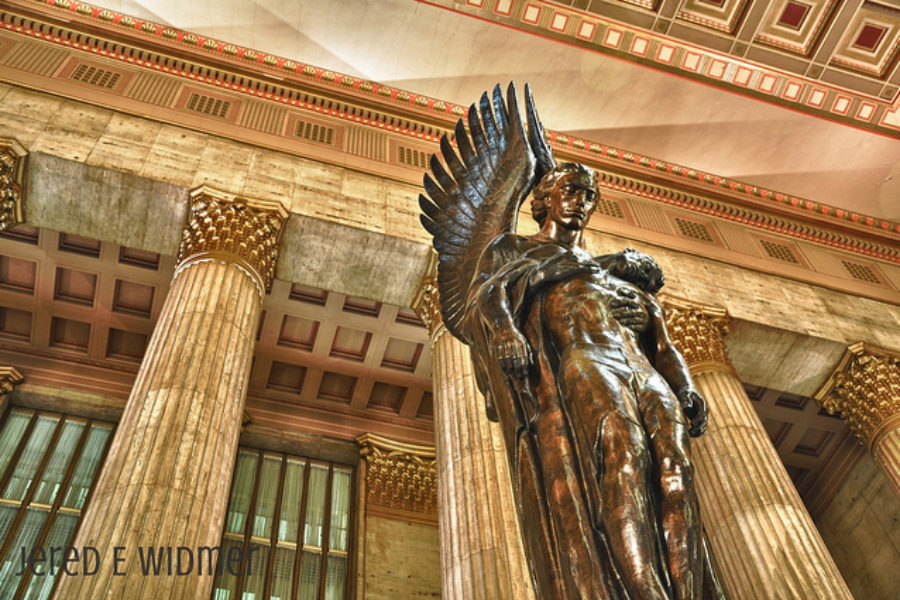Pictured above is the 28 foot high bronze sculpture Angel of the Resurrection which stands in Philadelphia’s 30th Street Station. It portrays Michael the Archangel lifting up a dead soldier from the flames of war. At its base are two inscriptions which read:
IN MEMORY OF THE MEN AND WOMEN OF THE PENNSYLVANIA RAILROAD WHO LAID DOWN THEIR LIVES FOR OUR COUNTRY 1941-1945.
THAT ALL TRAVELERS HERE MAY REMEMBER THOSE OF THE PENNSYLVANIA RAILROAD WHO DID NOT RETURN FROM THE SECOND WORLD WAR.
There are four bronze plaques listing the 1,307 names of the dead.
The memorial was dedicated in 1952 by General Omar Bradley, Chairman of the Joints Chief of Staff. It was unveiled by Army Sergeant Robert E. Laws, a recipient of the Medal of Honor for his bravery in combat in the Philippines, and an employee of the railroad.
It is a very powerful, moving and sobering work of art. Every time I am in the station, I look up at the memorial and say a prayer for my friends and all of those who have died in our wars.

For all of the cook outs, trips, parties and family gatherings this Memorial Day week-end, it would be well to recall the true purpose of the observance. It is an event built around the remembrance of the deaths and sacrifices of those who have served in our armed forces.
My father, a World War II veteran, had a first cousin who fought in World War I as a Regimental Sergeant Major in the British Army. Many years ago, during a visit to Wales, I had the privilege of spending the day with the old sergeant. He was living on the farm where my grandfather lived before he departed for America. He showed me the windowsill where my grandfather had carved his initials his last night there.
And then he took out a box that was filled with mementos of his military career. There were campaign ribbons, medals and faded sepia-toned photos of grinning young soldiers posing with rifles, manning machine guns, and marching. As he showed me each photo, he would carefully point out his friends and tell me their fate. This one was wounded, that one was killed in battle, another one was gassed and died in hospital, and so on.
He wasn’t maudlin about it. But, even though his recital was quite matter of fact, there was the faintest hint of grief in his voice. This was over fifty years after his war had ended, but the muted sorrow was still there.
In 1976, the Scottish-born Australian folk singer Eric Bogle wrote “No Man’s Land”, an evocatively sad ballad about the death of a 19 year old British soldier in the Great War. When I first heard it, I thought of the sergeant and his photographs. And it occurred to me that, given its universal theme of loss, the ballad, also called “The Green Fields of France”, could well be the anthem of Memorial Day.
Here’s a wonderful performance of “No Man’s Land” by Saffyre. Please take a listen and ponder its message as you think of our fallen.


Leave a Reply
Leave a reply.